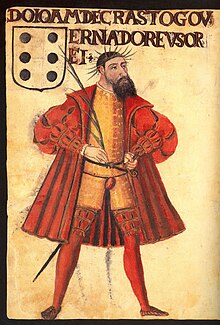João de Castro
João de Castro | |
|---|---|
 Portrait of D. João de Castro in Livro de Lisuarte de Abreu, c. 1560. | |
| Governor and Viceroy of India | |
| In office 1545–1548 | |
| Monarch | John III |
| Preceded by | Martim Afonso de Sousa |
| Succeeded by | Garcia de Sá |
| Personal details | |
| Born | 27 February 1500 Lisbon, Portugal |
| Died | 6 June 1548 (aged 48) Goa, India |
| Military service | |
| Allegiance | Portuguese Empire |
| Battles/wars |
|
Early life
As the younger son of Álvaro de Castro, João was destined for the church. He studied
Voyages to India and the expedition to Egypt
In 1535 de Castro accompanied Dom Luís to the
Soon after, de Castro left for India with his uncle Garcia de Noronha, and participated in the relief of Diu upon his arrival at Goa. In 1540 he served on an expedition to Suez under Estêvão da Gama (the son of Vasco da Gama and then viceroy of India), who knighted his son, Álvaro de Castro in recognition of D. João.[3] After Noronha's death, da Gama succeeded him, and de Castro joined da Gama on an expedition to the Red Sea. Da Gama departed on 31 December 1540, with 12 large galleons (one of which was captained by de Castro) and carracks, and 60 galleys.
De Castro kept a detailed journal of the voyage with maps, calculations, pictures, and detailed notes of the coasts of the Arabian Peninsula and regions that are known as Somalia, Eritrea, Ethiopia, Sudan, and Egypt today. He traveled to Suez and other ports on the shores of the Sinai Peninsula, all included in the Roteiro do Mar Roxo.
Unlike other viceroys, Castro was interested in Indian culture and religion. He collaborated with the humanist
Later life
Returning to Portugal, de Castro was named commander of a fleet in 1543 to clear
After the victory of his Armada in the relief of Diu, he asked the king to not prolong his term of office beyond the ordinary three years and to allow him to return to the Sintra Mountains in Portugal. After his victory over Mahmud and the Adil Khan, de Castro rebuilt Diu with the money received from the citizens of Goa. He did not live long enough to fulfill this goal, and died in the arms of his friend, Saint Francis Xavier, on 6 June 1548.[3]
He was buried at Goa before his remains were exhumed and transported to Portugal to be reinterred in the convent of
The terrestrial magnetism in the Roteiro from Lisbon to Goa: the experiences of João de Castro
The ancient Greeks had discovered that a dark metallic stone could
De Castro's recorded values of magnetic declination in the
Notes
- ^ Freire de Andrade, Jacinto (1664). The life of Dom John de Castro, the fourth viceroy of India wherein are seen the Portuguese's voyages to the East-Indies, their discoveries and conquests there, the form of government, commerce, and discipline of warr in the east, and the topography of all India and China : containing also a particular relation of the most famous siege of Dio, with a map to illustrate it / by Jacinto Freire de Andrada, written in Portuguese ; and by Sr Peter Wyche, Kt., translated into English. — Vida de Dom João de Castro, quarto viso-rey da India. English.
- ^ Thomas, David; Chesworth, John. "Asia, Africa and South America". Christian-Muslim Relations. A Bibliographical History. Volume 7 Central and Eastern Europe, Asia, Africa and South America (1500-1600).
- ^ a b c d e Chisholm 1911.
- ^ "The road to the magnetic north pole".
- ^ "Archived copy" (PDF). Archived from the original (PDF) on 2012-10-26. Retrieved 2011-08-14.
{{cite web}}: CS1 maint: archived copy as title (link)
References
- This article incorporates text from a publication now in the public domain: Chisholm, Hugh, ed. (1911). "Castro, João de". Encyclopædia Britannica. Vol. 5 (11th ed.). Cambridge University Press. p. 484.
- Jacinto Freire de Andrade Vida de D. João de Castro, Lisbon, 1651 (English translation by Sir Peter Wyche in 1664).
- Diogo de Couto, Décadas da Ásia, VI.
- The Roteiros, or logbooks of Castro's voyages in the East (Lisbon, 1833, 1843 and 1872) are of great interest.

